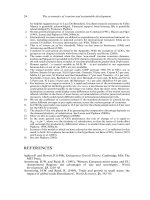THE ECONOMICS OF MONEY,BANKING, AND FINANCIAL MARKETS 383
Bạn đang xem bản rút gọn của tài liệu. Xem và tải ngay bản đầy đủ của tài liệu tại đây (41.75 KB, 1 trang )
CHAPTER 14
Risk Management with Financial Derivatives
351
contract and thereby agreed to buy (take delivery of ) the bonds are said to have
taken a long position, and parties who have sold a futures contract and thereby
agreed to sell (deliver) the bonds have taken a short position.
To make our understanding of this contract more concrete, let s consider what
happens when you buy or sell one of these Canada bond futures contracts. Let s
say that on January 1, you sell one $100 000 March contract at a price of 115 (that is,
$115 000). By selling this contract, you agree to deliver $100 000 face value of the
long-term Canada bonds to the contract s counterparty at the end of March for
$115 000. By buying the contract at a price of 115, the buyer has agreed to pay
$115 000 for the $100 000 face value of bonds when you deliver them at the end of
March. If interest rates on long-term bonds rise so that when the contract matures at
the end of March the price of these bonds has fallen to 110 ($110 000 per $100 000
of face value), the buyer of the contract will have lost $5000 because he or she paid
$115 000 for the bonds but can sell them only for the market price of $110 000. But
you, the seller of the contract, will have gained $5000 because you can now sell the
bonds to the buyer for $115 000 but have to pay only $110 000 for them in the market.
It is even easier to describe what happens to the parties who have purchased
futures contracts and those who have sold futures contracts if we recognize the
following fact: At the expiration date of a futures contract, the price of the
contract is the same as the price of the underlying asset to be delivered. To
see why this is the case, consider what happens on the expiration date of the
March contract at the end of March when the price of the underlying $100 000 face
value Canada bond is 110 ($110 000). If the futures contract is selling below 110,
say, at 109, a trader can buy the contract for $109 000, take delivery of the bond,
and immediately sell it for $110 000, thereby earning a quick profit of $1000.
Because earning this profit involves no risk, it is a great deal that everyone would
like to get in on. That means that everyone will try to buy the contract, and as a
result, its price will rise. Only when the price rises to 110 will the profit opportunity cease to exist and the buying pressure disappear. Conversely, if the price of
the futures contract is above 110, say, at 111, everyone will want to sell the contract. Now the sellers get $111 000 from selling the futures contract but have to pay
only $110 000 for the Canada bonds that they must deliver to the buyer of the contract, and the $1000 difference is their profit. Because this profit involves no risk,
traders will continue to sell the futures contract until its price falls back down to
110, at which price there are no longer any profits to be made. The elimination of
riskless profit opportunities in the futures market is referred to as arbitrage, and
it guarantees that the price of a futures contract at expiration equals the price of
the underlying asset to be delivered.1
Armed with the fact that a futures contract at expiration equals the price of the
underlying asset makes it even easier to see who profits and loses from such a contract when interest rates change. When interest rates have risen so that the price of
the Canada bond is 110 on the expiration day at the end of March, the March
Canada bond futures contract will also have a price of 110. Thus if you bought the
contract for 115 in January, you have a loss of 5 points, or $5000 (5% of $100 000).
But if you sold the futures contract at 115 in January, the decline in price to 110
means that you have a profit of 5 points, or $5000.
1
In actuality, futures contracts sometimes set conditions for delivery of the underlying assets that cause
the price of the contract at expiration to differ slightly from the price of the underlying assets. Because
the difference in price is extremely small, we ignore it in this chapter.









